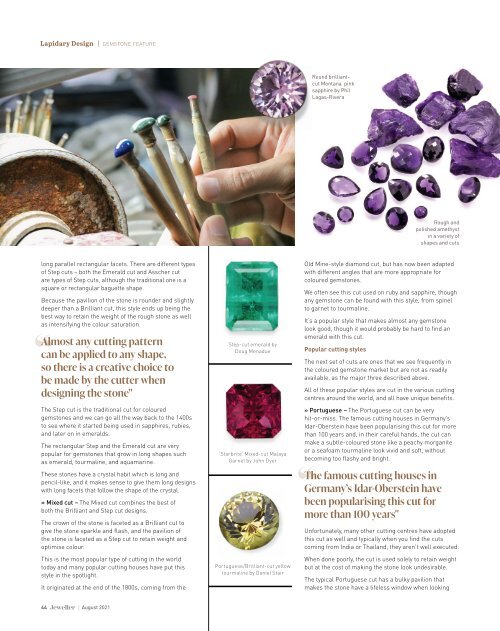You also want an ePaper? Increase the reach of your titles
YUMPU automatically turns print PDFs into web optimized ePapers that Google loves.
Lapidary Design | GEMSTONE FEATURE<br />
Round brilliantcut<br />
Montana pink<br />
sapphire by Phil<br />
Lagas-Rivera<br />
Rough and<br />
polished amethyst<br />
in a variety of<br />
shapes and cuts<br />
long parallel rectangular facets. There are different types<br />
of Step cuts – both the Emerald cut and Asscher cut<br />
are types of Step cuts, although the traditional one is a<br />
square or rectangular baguette shape.<br />
Because the pavilion of the stone is rounder and slightly<br />
deeper than a Brilliant cut, this style ends up being the<br />
best way to retain the weight of the rough stone as well<br />
as intensifying the colour saturation.<br />
Almost any cutting pattern<br />
can be applied to any shape,<br />
so there is a creative choice to<br />
be made by the cutter when<br />
designing the stone"<br />
The Step cut is the traditional cut for coloured<br />
gemstones and we can go all the way back to the 1400s<br />
to see where it started being used in sapphires, rubies,<br />
and later on in emeralds.<br />
The rectangular Step and the Emerald cut are very<br />
popular for gemstones that grow in long shapes such<br />
as emerald, tourmaline, and aquamarine.<br />
These stones have a crystal habit which is long and<br />
pencil-like, and it makes sense to give them long designs<br />
with long facets that follow the shape of the crystal.<br />
» Mixed cut – The Mixed cut combines the best of<br />
both the Brilliant and Step cut designs.<br />
The crown of the stone is faceted as a Brilliant cut to<br />
give the stone sparkle and flash, and the pavilion of<br />
the stone is faceted as a Step cut to retain weight and<br />
optimise colour.<br />
This is the most popular type of cutting in the world<br />
today and many popular cutting houses have put this<br />
style in the spotlight.<br />
It originated at the end of the 1800s, coming from the<br />
Step-cut emerald by<br />
Doug Menadue<br />
'Starbrite' Mixed-cut Malaya<br />
Garnet by John Dyer<br />
Portuguese/Brilliant-cut yellow<br />
tourmaline by Daniel Stair<br />
Old Mine-style diamond cut, but has now been adapted<br />
with different angles that are more appropriate for<br />
coloured gemstones.<br />
We often see this cut used on ruby and sapphire, though<br />
any gemstone can be found with this style, from spinel<br />
to garnet to tourmaline.<br />
It’s a popular style that makes almost any gemstone<br />
look good, though it would probably be hard to find an<br />
emerald with this cut.<br />
Popular cutting styles<br />
The next set of cuts are ones that we see frequently in<br />
the coloured gemstone market but are not as readily<br />
available, as the major three described above.<br />
All of these popular styles are cut in the various cutting<br />
centres around the world, and all have unique benefits.<br />
» Portuguese – The Portuguese cut can be very<br />
hit-or-miss. The famous cutting houses in Germany’s<br />
Idar-Oberstein have been popularising this cut for more<br />
than 100 years and, in their careful hands, the cut can<br />
make a subtle-coloured stone like a peachy morganite<br />
or a seafoam tourmaline look vivid and soft, without<br />
becoming too flashy and bright.<br />
The famous cutting houses in<br />
Germany’s Idar-Oberstein have<br />
been popularising this cut for<br />
more than 100 years"<br />
Unfortunately, many other cutting centres have adopted<br />
this cut as well and typically when you find the cuts<br />
coming from India or Thailand, they aren’t well executed.<br />
When done poorly, the cut is used solely to retain weight<br />
but at the cost of making the stone look undesirable.<br />
The typical Portuguese cut has a bulky pavilion that<br />
makes the stone have a lifeless window when looking<br />
44 | <strong>August</strong> <strong>2021</strong>


















